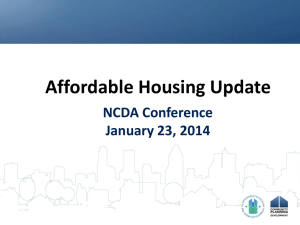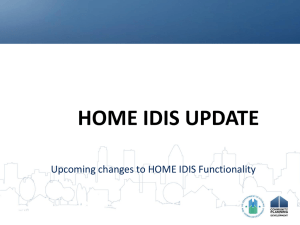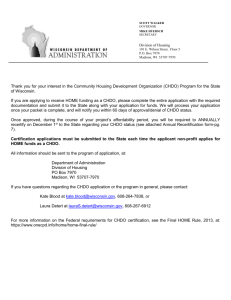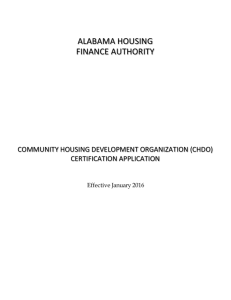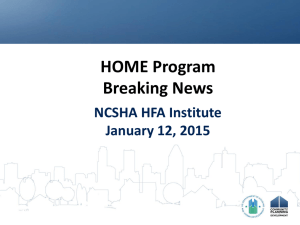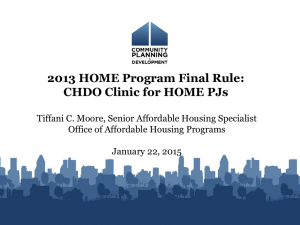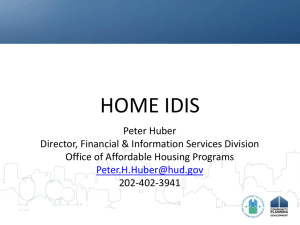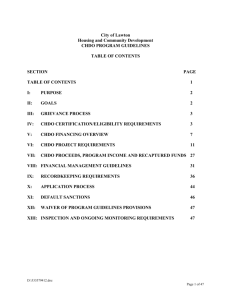CHDO as Developer
advertisement
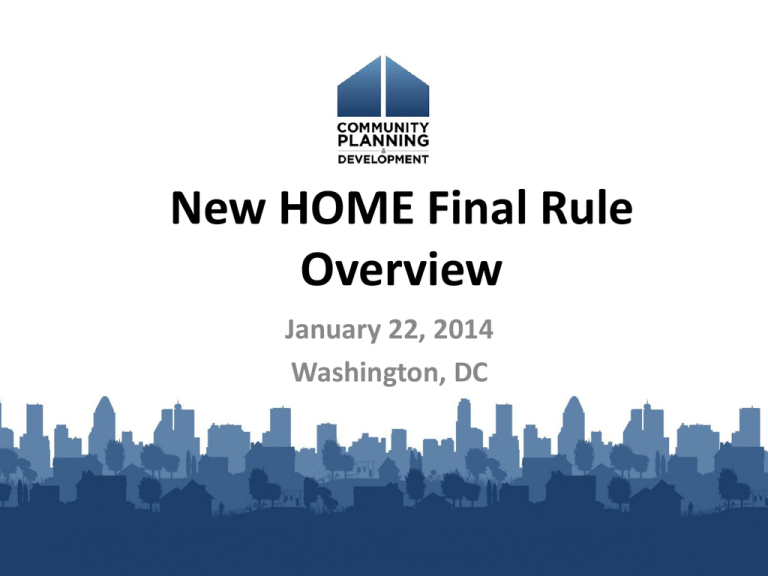
New HOME Final Rule Overview January 22, 2014 Washington, DC Key Changes • Program and Project Timeframes • CHDO Reservation • Written Agreements • Subsidy Layering & Underwriting • Written Policies & Procedures • Project Completion Definition • Property Standards • Match • Homebuyer Program Design • Oversight of Rental Projects • New and revised CHDO Roles • CHDO Capacity Slide 2 Effective Dates – §92.3 In general, requirements apply to projects to which HOME funds are committed to on/after August 23, 2013 Req’ts w/Delayed Implementation Effective Date Project-specific CHDO reservations October 22, 2013 [implemented for 2015 deadlines Homebuyer Procedures (§ 92.254(f)) January 24, 2014 Section 92.504(a): written policies, procedures, and systems July 24, 2014 Section 92.504(d)(2): financial oversight July 24, 2014 5-year CHDO expenditure deadline Implemented for 2015 deadlines Property standards, utility allowances, inspection protocol (§ 92.251) January 24, 2015 Slide 3 Definitions – §92.2 Commitment • PJs may not commit HOME funds to a project consisting of new construction or rehabilitation until: – All necessary financing is secured – A budget and production schedule is established – Underwriting and subsidy layering is completed – Construction is expected to start within 12 months Slide 4 Definitions – §92.2 Commitment • A PJ can make a preliminary award of HOME funds for a proposed project to facilitate applications for other financing: – These preliminary agreements must be contingent on obtaining financing, completing environmental review, etc. – Preliminary awards are not commitments and CANNOT be entered into IDIS. A new legally binding agreement must be executed Slide 5 Definitions – §92.2 Commitment (cont.) • Dated signatures are required on written agreements • Agreements that are no longer commitments: – Between PJ and a subrecipient that the PJ controls (e.g., agency whose officials/employees work for the PJ) – Lead consortium entity with other consortium members Slide 6 Definitions — §92.2 Project Completion • A project is “complete” when: – All construction work is complete/property standards met – Final drawdown of HOME funds disbursed – Project completion information (beneficiary data) entered into IDIS – If homebuyer, final transfer has occurred • For rental only: – Project can be completed in IDIS with units marked vacant. Beneficiary data must be entered at a later date. Slide 7 New Deadline Requirements • Project Deadlines: – 4-year project completion deadline – 9-month deadline for sale of homebuyer units – 18-month rental occupancy deadline • 5-year CHDO expenditure deadline Slide 8 4-year Project Completion Deadline – §92.205(e)(2) • Projects must be completed within 4 years of date of commitment • Completion occurs when project meets the definition of “project completion” at §92.2 • 1-year extension possible Slide 9 Homebuyer Unit Sale Deadline • New rule establishes a 9-month deadline for sale of homebuyer units – Timeframe begins at construction completion to “sale” to eligible homebuyer • Sale can be demonstrated by ratified sales contract – PJs must convert unsold units to HOME rental units or repay the HOME funds. • May enter lease-purchase only if PJ has an established leasepurchase program AND lease-purchase agreement is executed before the 9 months has elapsed. Slide 10 Rental Unit Lease-Up Deadline • New rule establishes an 18-month deadline for initial occupancy of HOME rental units – If unit is not leased 6 months after project completion, PJ must submit existing marketing plan to Field Office. FO may require PJ to develop an “enhanced” marketing plan – If unit not leased 18 months after project completion, the PJ must repay the funds invested in the unit to its HOME Account (pro rata amount or actual cost of the unit) Slide 11 Subsidy Layering and Underwriting – §92.250(b) • PJs must adopt guidelines for determining reasonable level of profit or return to owner/developer (PJ certifies this in Action Plan) – Establish standard for the size, type, and complexity of project • PJs may not invest more HOME funds, alone or in combination with other government funding, than is necessary to provide quality affordable housing that is financially viable Slide 12 Subsidy Layering and Underwriting – §92.250(b) • For each project, PJs must: – Evaluate return to owner/developer – Examine sources & uses; determine that costs are reasonable – Assess neighborhood market demand for project – Assess developer experience and financial capability – Assess firm written financial commitments Slide 13 Applicability of Subsidy Layering & Underwriting Requirements Slide 14 Written Agreements – §92.504(c) • New rule revises written agreement requirements to make them a more effective compliance, management and enforcement tool for PJs • PJs must update written agreement templates to reflect all new rule requirements (not just those revisions in §92.504(c)) Slide 15 Eligible Costs • TBRA: cost of unit inspections and income determinations are eligible project-related soft costs (§92.209(a)) • Project Pre-Development Costs: PJs may reimburse developers for project-related soft costs incurred up to 24 months before commitment of HOME funds (§92.206(d)(1)) – Eligible soft costs are those necessary to develop and prepare plans, drawings, specs or work write-ups, etc. – Written agreement must specifically permit this reimbursement Slide 16 Match Credit – §92.221 • Eligible match contributions for homebuyer development projects narrowed • A contribution to the development of homebuyer housing only counts as match to the extent that it: – reduces the sales price of the housing below fair market value OR – enables the unit to be sold for less than the cost of development (if the development cost of a unit exceeds the market value) Slide 17 Homebuyer Changes Slide 18 Forms of Ownership Owner Occupied Rehab – §92.254(c) • Rule permits HOME assistance for homeowner rehabilitation in the following situations which do not meet the §92.2 definition of homeownership: – Inherited property with multiple owners – Life estates – Inter vivos trust or living trusts – Beneficiary deed Slide 19 Homeownership Value Limits – §92.254(a)(2)(iii) • HOME statute requires initial purchase price/after rehab value not to exceed 95% of area median purchase price • Continued use of 203(b) FHA Single Family Mortgage Limit would violate statute; new rule eliminates use of 203(b) in HOME Slide 20 Homeownership Value Limits – §92.254(a)(2)(iii) (cont.) • HUD published two 95% of median purchase price/after rehab value data sets: – Newly constructed housing – Existing housing • 2014 Limits are the greater of the Countywide 95% figure or MSA-wide 95% figure Slide 21 Housing Counseling – §92.254(a)(3) • Housing Counseling required for all homebuyers receiving HOME assistance or purchasing homebuyer units developed with HOME funds • Counseling costs may be charged to: – HOME administrative set-aside – As project-related soft cost, or – To homebuyer, if the fee is reasonable Slide 22 Housing Counseling – §92.254(a)(3) (cont.) • PJ’s have flexibility as to provider (PJ, HUD approved counseling agency, or other provider), content and length • CFPB will issue regulations regarding housing counseling that will apply to HOME • Current voluntary national standards can be found at: http://www.homeownershipstandards.com Slide 23 Sustainable Homeownership Program Design – §92.254(f) • Rule requires PJs to develop and follow written policies and procedures for: – Underwriting homebuyer assistance – Responsible lending, and – Resubordination of HOME debt in the event of private debt refinancing • Effective January 24, 2014 Slide 24 Sustainable Homeownership Underwriting – §92.254(f) • PJ must develop and follow written underwriting standards that evaluate the homebuyer regarding: – Housing debt and overall debt – Monthly expenses of the family – Assets available to acquire housing – Financial resources available to sustain housing • Goal is appropriate amount of HOME assistance Slide 25 Sustainable Homeownership Responsible Lending – §92.254(f) • Rule requires written policies to ensure private mortgages obtained by homebuyers are sustainable (e.g., no predatory loans) – PJ should develop standards based on loan characteristics • HUD will issue guidance to assist PJs in developing responsible lending guidelines Slide 26 Resale and Recapture – §92.254(a)(5) • Rule makes several changes to resale and recapture requirements including: – Resale: PJs must clearly define “fair return” and “reasonable range of low-income homebuyers” – Recapture: Permits subsequent low-income homebuyer to assume HOME loan and recapture obligation if no additional HOME assistance is provided Slide 27 Rental Changes Slide 28 HOME Rents – §92.252 • Clarifies that PJs may designate more than 20% of HOME units as Low HOME Rent units • Requires PJs to annually review and approve rents for each HOME-assisted rental project – Ensures compliance with HOME rent limits – Prohibits undue rent increases from previous years Slide 29 HUD Utility Schedule – §92.252(d) • Rule requires PJs to determine individual utility allowance for each rental project, by: – Using HUD Utility Schedule Model, or – Determining utility allowance for a project based on the specific utilities used at the project • Utility allowances for each project must be updated annually Slide 30 Inspections – §92.504(d) • Owner must certify annually units are suitable for occupancy • PJs must have inspection procedures (92.251(f)(5)) • Required inspections: – At construction completion, and within 12 months of completion, and at least every 3 years thereafter – Projects found to have health/safety issues: PJ must adopt a more frequent inspection schedule for problem properties Slide 31 Inspections – §92.504(d) (cont.) • Inspection sample size: – 1-4 HOME–assisted units • 100% of units must be inspected – 5+ HOME-assisted units • Statistically valid sample • HUD will provide guidance through notice Slide 32 Financial Oversight – §92.504(d)(2) • PJs must annually review financial condition of rental projects with 10 or more HOME units • If problem identified, must take action including: – More frequent reporting and monitoring – Provide technical assistance – Assist in identifying additional non-federal funding or another appropriate owner • Effective July 24, 2014 Slide 33 Troubled Projects – §92.210 • New section addresses rental projects that become financially unviable during affordability period – Troubled Project = operating costs significantly exceed operating revenue • HUD HQ may approve additional HOME $$ if new + old HOME funds do not exceed current subsidy limits • HUD HQ may approve reduction in number of HOME-assisted units if original number higher than minimum required Slide 34 CHDO Changes Slide 35 Own, Develop or Sponsor • Own, Develop, Sponsor roles codified in rule for first time at §92.300(a)(2) - (6) • Roles have been clarified and/or redefined; changes will increase number of organizations that can access CHDO set-aside funds • A CHDO must demonstrate capacity in relation to its “role” • Assistance must be provided to the entity that owns the project. Slide 36 CHDO as Owner • CHDO acts as owner of rental housing that it does not develop • CHDO is owner in fee simple or has long-term ground lease during development and affordability period • CHDO acquires standard housing, or hires project manager or contracts with developer to perform rehab or construction Slide 37 CHDO as Developer • CHDO owns (in fee simple absolute or holds longterm ground lease) and develops housing • CHDO arranges financing and is in sole charge of construction or rehab • For Rental projects: CHDO owns the project during development and throughout period of affordability, and performs all development activities Slide 38 CHDO as Developer • For Homebuyer projects: CHDO owns, rehabs or constructs, then sells property • Written agreement with CHDO must include: – Actual sales price or method for determining it – Disposition of proceeds of sale (return to PJ or permit CHDO to retain), and use of proceeds if CHDO will retain Slide 39 CHDO as Sponsor CHDOs can sponsor rental housing in 2 ways: 1) CHDO develops rental housing on behalf of another non-profit or CHDO and transfers title after construction completion • Conveyed at pre-determined time to pre-identified nonprofit/CHDO Slide 40 CHDO as Sponsor 2) Rental housing is “sponsored” by CHDO if owned or developed by: • For-profit or nonprofit that is wholly-owned subsidiary of the CHDO; • Limited partnership (LP) of which the CHDO or its subsidiary is sole general partner; or • Limited liability company (LLC) of which the CHDO or its subsidiary is sole managing member. – Written agreement must be signed by PJ and entity that will own the project Slide 41 CHDO as Sponsor • If partnership agreement permits removal of CHDO as sole managing member or partner, removal must only be permitted for cause • Partnership agreement must specify that CHDO must be replaced with another CHDO Slide 42 CHDO Staff Capacity • CHDOs must have paid staff with demonstrated capacity appropriate to CHDO’s role: – Can be full-time or part-time – Can be contract employees – Cannot meet capacity requirement based on use of volunteers, donated staff, shared staff or board members – Use of consultants to demonstrate capacity ONLY during the 1st year of operation as a CHDO Slide 43 CHDO Staff Capacity Staff must have experience/capacity relevant to project and role as owner, developer, or sponsor • CHDO as Owner: Staff must have capacity to act as owner (this may mean the ability to oversee development) • CHDO as Developer or Sponsor: Staff must have development experience on projects of similar scope or complexity Slide 44 Organizations that create CHDOs • For-profit & governmental entities that create CHDOs: — Pre-2013 rule: Organizations that create a CHDO cannot appoint more than 1/3 of board members; Those appointed board members may not appoint other 2/3 of board — New rule: Adds prohibition against officers or employees of organization that created CHDO serving as officers or employees of CHDO Slide 45 Organizations that create CHDOs • For Governmental or Public Organizations: — Includes PJs, public housing agencies, HFAs, redevelopment authorities, Indian Tribes —Officers or employees of a governmental entity may not serve as employees of a CHDO Slide 46
